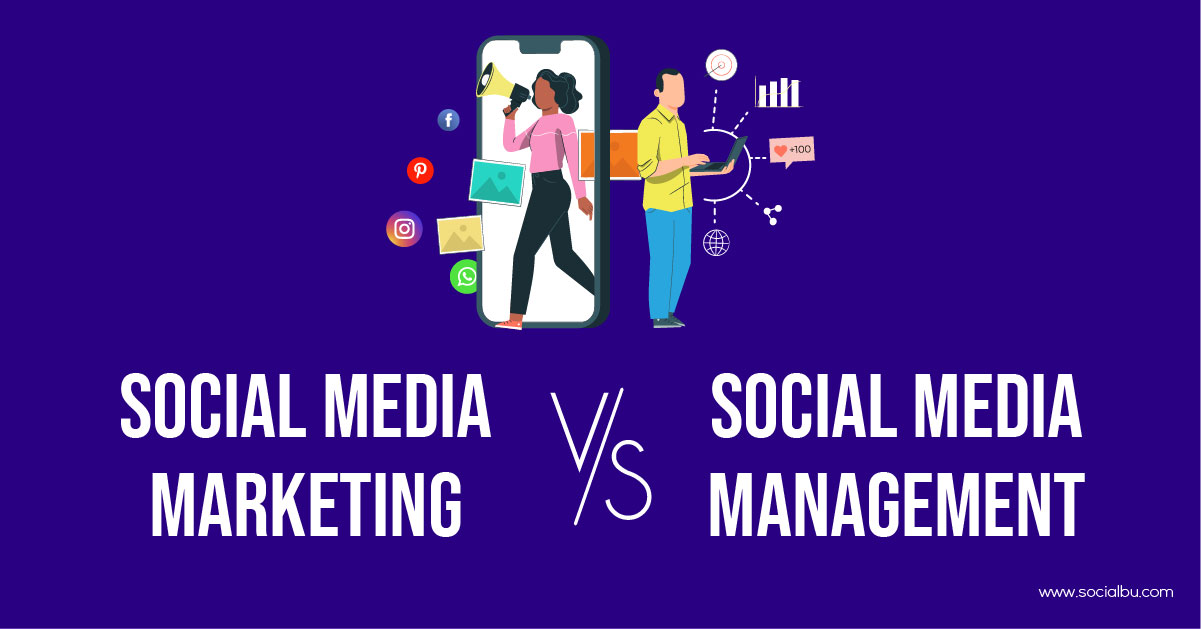Social media management involves creating, scheduling, analyzing, and engaging with content posted on social media platforms. Social media marketing uses these platforms to promote products or services.
Social media management and marketing are crucial for modern businesses. They help in building brand awareness, engaging with customers, and driving sales. Effective management involves consistent posting, monitoring analytics, and responding to audience interactions. Marketing on social media includes targeted advertising, influencer partnerships, and content creation.
These strategies increase visibility and attract potential customers. Businesses can leverage various platforms like Facebook, Instagram, Twitter, and LinkedIn. Social media tools and analytics help track performance and optimize campaigns. This approach ensures a strong online presence and competitive advantage.
Introduction To Social Media Management
Social media marketing is a powerful tool for businesses. It helps them reach a larger audience. The core components make it effective. Let’s dive into the key elements.
Content Creation
Content creation is crucial in social media marketing. It involves producing engaging posts, videos, and graphics. Good content captures the audience’s attention. It helps in building brand awareness. Here are some essential types of content:
- Text Posts: Short, catchy, and informative.
- Images: High-quality photos and infographics.
- Videos: Short clips, tutorials, and behind-the-scenes.
- Stories: Temporary posts that engage followers.
Content should be relevant to the audience. It must align with the brand’s voice and values. Consistency in posting is key to keeping followers engaged.
Engagement Strategies
Engagement strategies are vital for social media success. They help in building relationships with followers. Engaging with your audience fosters loyalty. Here are some effective strategies:
- Respond to Comments: Reply to comments on your posts.
- Ask Questions: Encourage followers to share their thoughts.
- Run Contests: Create fun and interactive contests.
- Use Polls: Conduct polls to gather opinions.
- Share User-Generated Content: Repost content created by followers.
These strategies make followers feel valued. They increase interaction on your posts. This boosts your social media presence.
Core Components Of Social Media Marketing
In the world of social media management and marketing, choosing the right platform is crucial. Each platform has unique features and user demographics. Below, we explore some of the most popular social media platforms that businesses use to connect with their audience.
Facebook And Instagram
Facebook is one of the largest social media platforms in the world. It offers a variety of tools for businesses. You can create business pages, run ads, and engage with customers. Facebook’s user base is diverse, making it ideal for reaching a wide audience.
Instagram is another powerful platform for businesses. It focuses on visual content. Instagram is great for brands that rely on images and videos. Use Instagram Stories, IGTV, and Reels to engage your audience. Its user base is younger, which is perfect for targeting millennials and Gen Z.
Twitter And Linkedin
Twitter is known for its real-time updates. Businesses use Twitter to share news and updates quickly. The platform allows for short, concise messages. Use hashtags to increase the visibility of your tweets. Twitter is effective for customer service and community engagement.
LinkedIn is the go-to platform for B2B marketing. It focuses on professional networking. LinkedIn is ideal for sharing industry news and insights. Use it to connect with professionals and decision-makers. LinkedIn also offers advertising options to target specific job titles and industries.
| Platform | Best For | User Base | Key Features |
|---|---|---|---|
| Wide Audience | Diverse | Business Pages, Ads | |
| Visual Content | Younger | Stories, IGTV, Reels | |
| Real-Time Updates | Varied | Hashtags, Short Messages | |
| Professional Networking | Professionals | Industry News, Ads |
Popular Social Media Platforms
Creating a solid social media strategy is essential for any business. It helps you connect with your audience and achieve your goals. A well-crafted strategy involves several key steps. These steps ensure your social media efforts are effective. Let’s dive into the crucial parts of developing a social media strategy.
Setting Goals
Start by setting clear and achievable goals. Goals give your strategy direction and purpose. Use the SMART criteria: Specific, Measurable, Achievable, Relevant, and Time-bound.
- Specific: Define what you want to achieve.
- Measurable: Ensure you can track progress.
- Achievable: Set realistic goals.
- Relevant: Align with your business objectives.
- Time-bound: Set a deadline for your goals.
For example, “Increase Instagram followers by 20% in three months” is a SMART goal.
Identifying Target Audience
Knowing your target audience is crucial. It allows you to tailor your content to their needs. Create detailed audience personas.
| Persona Element | Description |
|---|---|
| Demographics | Age, gender, location, and income. |
| Interests | Hobbies, preferences, and likes. |
| Challenges | Problems they need solutions for. |
| Behavior | Online habits and purchasing behavior. |
With personas, you can create content that resonates with your audience. This increases engagement and effectiveness.

Credit: www.linkedin.com
Developing A Social Media Strategy
Effective social media management requires strategic content planning and scheduling. This ensures your posts reach the right audience at the right time. It enhances engagement and builds a consistent online presence. Let’s delve into the key aspects of content planning and scheduling.
Content Calendar
A content calendar is a tool for organizing and scheduling posts. It helps in visualizing content distribution over a specific period. This tool ensures a balanced mix of content types, such as text, images, and videos.
- Plan content for each platform
- Set goals and objectives for each post
- Track past performance to guide future content
Here’s a simple table to illustrate a weekly content calendar:
| Day | Platform | Content Type | Topic |
|---|---|---|---|
| Monday | Image Post | Motivational Quote | |
| Tuesday | Text Tweet | Industry News | |
| Wednesday | Story | Behind-the-Scenes | |
| Thursday | Article | Expert Tips | |
| Friday | Infographic | Weekly Recap |
Optimal Posting Times
Identifying optimal posting times is crucial for maximizing engagement. Different platforms have unique peak times. Posting at these times can significantly boost interaction rates.
- Research best times for each social media platform
- Use analytics tools to track audience activity
- Adjust posting schedule based on performance data
Here’s a quick reference for optimal posting times:
| Platform | Best Time |
|---|---|
| 1 PM – 3 PM | |
| 12 PM – 1 PM | |
| 11 AM – 1 PM | |
| 8 AM – 10 AM | |
| 8 PM – 11 PM |
These times are a starting point. Regularly review and tweak your schedule for optimal results.
Content Planning And Scheduling
Understanding success in social media management and marketing is crucial. Analytics help track your performance. They show what works and what doesn’t. By measuring results, you can improve strategies and achieve goals.
Key Metrics
To measure success, you need to track key metrics. These metrics provide insights into your performance.
- Engagement Rate: Measures how people interact with your content.
- Reach: Shows how many people see your posts.
- Impressions: Counts how often your content appears on screens.
- Click-Through Rate (CTR): Indicates how many click your links.
- Conversion Rate: Tracks how many take action after clicking.
Data-driven Decisions
Using data helps make smarter decisions. It allows you to optimize your strategies.
| Metric | Action |
|---|---|
| Low Engagement Rate | Improve content quality |
| High Reach | Increase posting frequency |
| Low CTR | Enhance call-to-action |
| High Conversion Rate | Invest in similar campaigns |
Data tells you what works. You can adjust your efforts accordingly. This ensures better results over time.
:max_bytes(150000):strip_icc()/SMM_Final_4188900-b14da77d5eee49019768a7b839a19efb.jpg)
Credit: www.investopedia.com
Tools For Social Media Management
Social media management is a dynamic field. It requires dedication and strategy. Managing social platforms can be tough. Challenges often arise and need solutions.
Common Obstacles
Every platform has its own rules. Keeping up with changes is hard. Algorithms update frequently. This affects visibility and engagement.
Managing multiple accounts is time-consuming. Each account needs unique content. Coordinating posts can be a headache. Consistency is key but hard to maintain.
Engaging with the audience is crucial. Responding to comments and messages takes time. Negative feedback needs careful handling. It can impact the brand image.
Tracking performance is complex. Metrics can be confusing. Analyzing data requires skill. Incorrect interpretations lead to poor decisions.
Solutions And Best Practices
Plan your content ahead. Use a content calendar. Schedule posts to save time. Consistency becomes easier with planning.
Use social media management tools. Tools like Hootsuite or Buffer help. They streamline posting across platforms. They also help track engagement.
Engage with your audience regularly. Respond promptly to comments. Address negative feedback professionally. Show appreciation for positive interactions.
Analyze data effectively. Use analytics tools. Understand key metrics like reach and engagement. Make informed decisions based on data.
Stay updated with platform changes. Follow industry news. Join social media forums. Adapt strategies as needed.
| Common Obstacles | Solutions and Best Practices |
|---|---|
| Keeping up with algorithm changes | Stay updated with platform changes |
| Managing multiple accounts | Use social media management tools |
| Engaging with the audience | Engage regularly and professionally |
| Tracking performance | Analyze data effectively |
Social media management has its challenges. With the right strategies, you can overcome them. Use tools and stay updated to succeed.

Credit: socialbu.com
Frequently Asked Questions
What Does A Social Media Marketing Manager Do?
A social media marketing manager creates and manages content, plans campaigns, engages with followers, and analyzes performance metrics.
What Do You Do In Social Media Management?
Social media management involves creating, scheduling, and analyzing content. It also includes engaging with followers and monitoring performance metrics.
Is Social Media Management A Good Career?
Yes, social media management is a good career. It offers creativity, growth opportunities, and high demand in various industries.
What Is A Social Media Management Job?
A social media management job involves creating, scheduling, and analyzing content for social media platforms. It engages audiences and grows online presence.
Conclusion
Mastering social media management and marketing is crucial for businesses. It enhances online presence and drives engagement. Effective strategies lead to better brand awareness and customer loyalty. By understanding and implementing these techniques, you can achieve significant growth and success.
Stay updated with trends to keep your approach fresh and impactful.